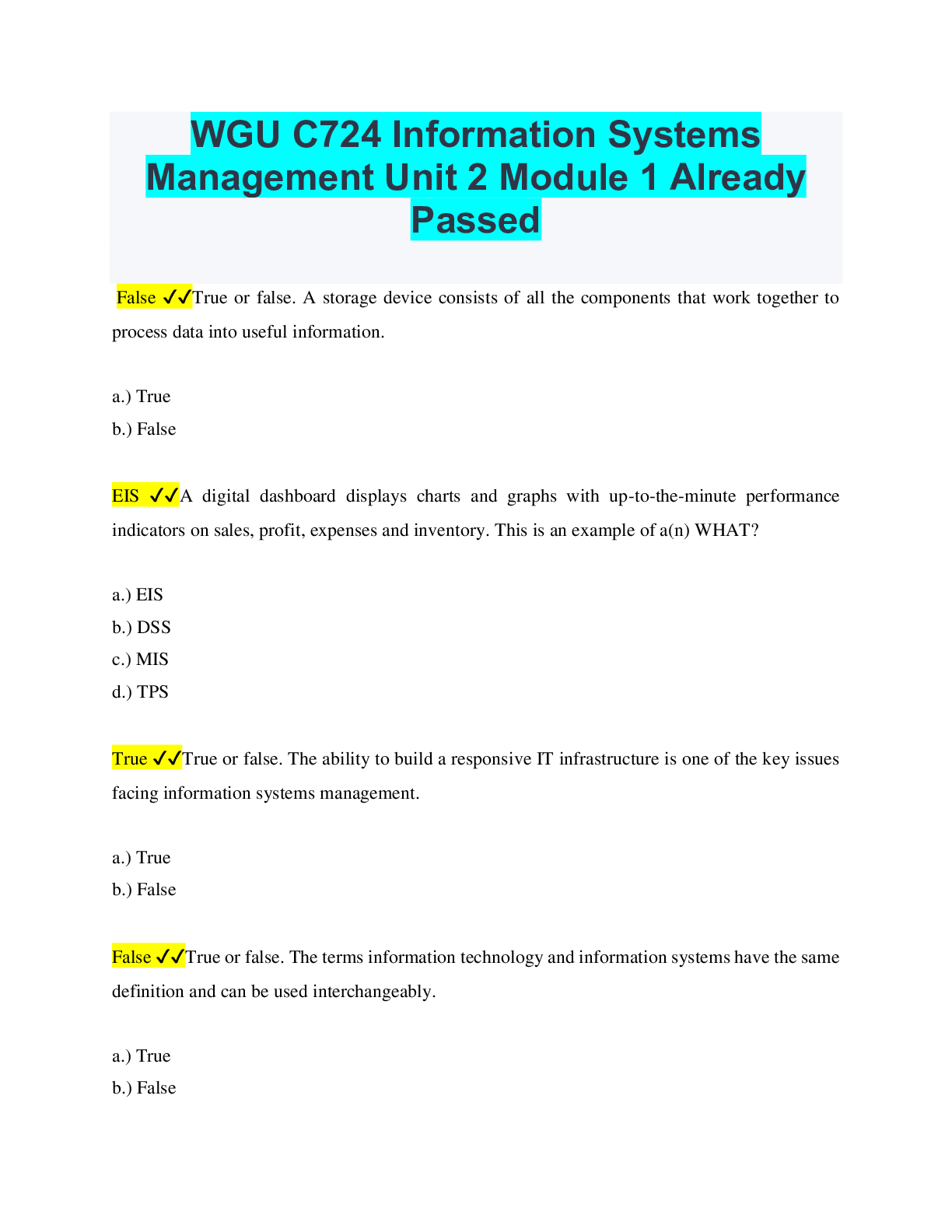Computer Science > QUESTIONS & ANSWERS > Intro to Cryptography WGU C839 Module 1 Already Passed (All)
Intro to Cryptography WGU C839 Module 1 Already Passed
Document Content and Description Below
Intro to Cryptography WGU C839 Module 1 Already Passed Most primitive of cryptographic algorithms, substitutes one character of cipher text for each character of plain text. Includes Caesar Cipher... Atbash Cipher Affine Cipher Rot13 Cipher ✔✔Mono-Alphabet Substitution First used by Julius Caesar Every letter is shifted a fixed number of spaces to the left or right the alphabet. ✔✔Caesar Cipher Hebrew Code substitutes the first letter of the alphabet for the last, and the second letter for the second to last. Simply reverses the alphabet ✔✔Atbash Cipher Each letter of the alphabet is mapped to some numeric value permuted by a simple mathematical function, and the converted back to a letter. basic formula for this cipher a = is some multiple x = represents the plain text b = is the shift M = the size of the alphabet example: ax + b (mod M) or 1x + 3 (mod 26) ✔✔Affine Cipher Single (Mono) alphabet cipher but all characters are rotated 13 characters through the alphabet. A Cat becomes N Png ✔✔ROT 13 Cipher Cylinder tool used by the Greeks, specifically attributed to the Spartans. A physical cylinder was used to encrypt messages. Turning the cylinder produced different cipher texts Must use a rod of the same diameter as the one used to create the message to decrypt it. ✔✔Scytale Cipher What do the following describe? Literacy rates have risen exponentially since cipher algorithms were first used. All languages have letter and word frequency. The most common in English is I and a, or ee and oo. ✔✔Single (mono) Substitution Weaknesses A way to make single (mono) substitution stronger is to rotate through various keys. The key adds 1 to the first letter then subtracts 1 from the second, then add 2 to the third and starts over on the fourth. +1 -1 +2. Used to counter word frequency, to complex to crack with pen and paper. Examples are: Cipher Disk Vigenere Cipher Enigma Machine ✔✔Multi (Poly)-Alphabet Substitution Invented by Leon Alberti in 1466 Each turn of the disk produced a new cipher Poly-Alphabet substitution ✔✔Cipher Disk Invented by Giovan Battista, Bellaso in 1553 Most widely known poly-alphabet cipher. Selects different mono-alphabet ciphers based on a key word (does not have to be a real word) ✔✔Vigenere Cipher First person to publish a successful general attack on Vigenere Cipher in 1863. ✔✔Friedrich Kasiski Invented by Charles Wheatstone and named after the Lord to promoted its use. Uses a 5x5 table containing a key word or phrase. The table is created by filling in the spaces with the key word. Dropping any duplicate and filling the remaining spaces with the alphabet. To encrypt a message you would break the message into groups of 2 letters, i.e. cheese becomes ch ee se and map them out on the key table. No more secure then any other classic cipher. ✔✔Playfair Cipher Invented by Fritz Nebel in 1918. it is a transposition cipher first used by the German Army in World War I. Uses a modified Polybius square A single columnar transposition A 36 letter alphabet with numbers 0-9 distributed randomly throughout a six by six square. ✔✔ADFGVX Cipher Early attempt to make substitution ciphers more robust by masking letter frequencies by mapping plain text letters to more then one cipher text "symbol". ✔✔Homophonic Substitution Messages are hidden in unrelated text. Sender and recipient have prearranged some patter for taking certain letters from the message ( the key). Leaving the intended message. Cipher Text: "We are having breakfast at noon at the cafe, Would that be okay?" Key: 3, 20, 22, 27, 32, 48 Message: "Attack" ✔✔Null Cipher Both parties agree to use a particular book as the basis. One person sends coordinates for words in the book. i.e. 3, 3, 10 means page 3 line 3 and the 10th word. ✔✔Book Cipher Most widely knowns transposition cipher. Take a word or message and alternate writing on a different row. Example: Attackatdawn Atcadw taktan ✔✔Rail Fence Cipher Used in World War II was an electromechanical rotor based cipher systems. When an operator pressed the A key, they would generate an F, but the next time they pressed A it might be D. Multi-alphabet cipher with 26 possible alphabets Allied cipher machines used were British TypeX and American SIGABA ✔✔Enigma Machine A tool that allows you to enter any text and choose a historic algorithm and encrypt it. ✔✔CrypTool [Show More]
Last updated: 1 year ago
Preview 1 out of 4 pages
Instant download
.png)
Buy this document to get the full access instantly
Instant Download Access after purchase
Add to cartInstant download
Also available in bundle (1)
.png)
WGU C839 BUNDLED EXAMS QUESTIONS AND ANSWERS WITH VERIFIED SOLUTIONS
WGU C839 BUNDLED EXAMS QUESTIONS AND ANSWERS WITH VERIFIED SOLUTIONS
By Nutmegs 1 year ago
$15
10
Reviews( 0 )
Document information
Connected school, study & course
About the document
Uploaded On
Sep 27, 2022
Number of pages
4
Written in
Additional information
This document has been written for:
Uploaded
Sep 27, 2022
Downloads
0
Views
80

.png)
.png)
.png)
.png)
.png)
.png)
.png)
.png)
.png)
.png)
.png)

.png)
.png)
.png)

.png)
.png)
.png)
.png)

